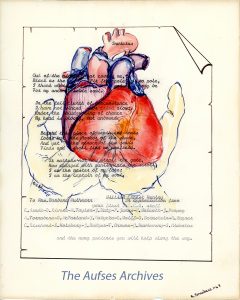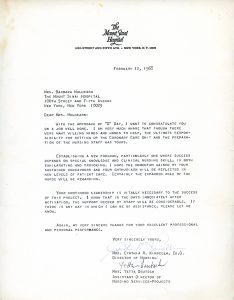Dec 8, 2017
In October of this year, The Mount Sinai Hospital announced the opening of the new cardiac unit, the former Cardiac Care Unit (CCU), now located on KCC 6 in the Klingenstein Clinical Center. There are 20 beds, ten of which are the Cardiac Intensive Care Unit (CICU) and ten are step-down beds, the Cardiac Step Down Unit (CSDU). Unlike the other ICU units, the ten ICU beds are all private rooms. The entire unit is beautiful, with a receptionist desk as you get off the elevator.
It just so happens that last year, the Aufses Archives received a small set of papers from Barbara McPeek Mulhearn, RN, Class of 1962 of The Mount Sinai Hospital School of Nursing. Among those items was information about Mulhearn’s role in creating the first Cardiac Care ICU at the Hospital, which opened in 1968. Her title was Assistant Nursing Supervisor in charge of the Ames Coronary ICU, an eight bed unit on the 4th floor of KCC. The Unit opened February 19, 1968.
Shown below are two pieces from the collection: a drawing of a heart held in a person’s hands with the poem “Invictus” by William Ernest Henley typed over it. This was sent to Mulhearn from “her first I.C.C.U. staff,” in appreciation from them “and the many patients you will help along the way.” Also shown here is a letter from Dr. Cynthia Kinsella, the Director of Nursing at The Mount Sinai Hospital at the time, thanking Mulhearn for her efforts and encouraging her as they neared the Unit opening.
Fifty years on, the caring legacy continues.


Oct 7, 2016

(Click to expand the image)
Sixty years ago this month, The Mount Sinai Hospital said goodbye to the last of a group of 25 women from Hiroshima, Japan who had spent over a year at the Hospital having surgeries to repair injuries they suffered in the nuclear blasts that ended World War II. The group of young women were called the Hiroshima
Maidens, and the project that brought them from Japan to the U.S. was the brainchild of Norman Cousins, the Editor of the Saturday Review of Literature. He raised the funds needed for the project and enlisted the help of the Quaker community of the metropolitan New York region to house the Maidens when they were not in the Hospital. Three surgeons from The Mount Sinai Hospital volunteered their time (Drs. Arthur Barsky, Bernard Simon and Sidney Kahn), and the President of the Hospital, Alfred Rose, anonymously paid for the use of four hospital beds for the duration of the project.
The Hiroshima Maidens project was a milestone in postwar American-Japanese relations. Before leaving Japan, the girls were told by some that the American doctors were going to experiment on them. As it became clear that this was not the case, the donated funds were stretched to allow Japanese doctors to come to Mount Sinai and receive training in plastic and reconstructive surgery, thus helping to strengthen the field in Japan.
The Hiroshima Maidens project continued to have life. In 1995, one of the Maidens returned to Mount Sinai to meet with Dr. Simon. At that time she gave the Mount Sinai Archives a scrapbook of photocopies of images from Hiroshima after the blast. The next year there was a conference at Mount Sinai that celebrated the project from 40 years before, and highlighted Mount Sinai’s current international efforts. In spring 2005, for the 50th anniversary of the project, the last remaining Maiden and a group of Japanese press visited Mount Sinai once again. The group came to the Archives and looked at the photos from the 1950s and read again the newspaper accounts of the Maidens’ courageous journey to New York.
On this 60th anniversary, it is unknown if any Maidens are still alive. Still, it is comforting to know that the memory – and documentation – of the project lives on, and will not be forgotten.



